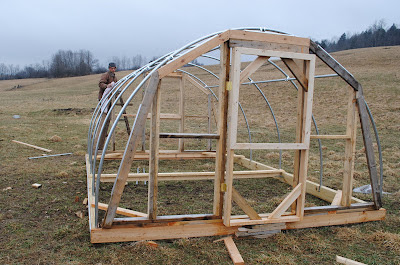
While our garden was quite productive last year, it got off to a rather difficult start. I started our leeks, tomatoes and celery in a soil block mix I'd made months earlier, and it must have developed a robust population of some undesirable fungus, because after a fine start, all of the celery and tomato seedlings drooped and then fell over as their roots rotted away beneath them. We only managed to salvage some of the leeks by transplanting them into clean soil, and I still wonder if it would not have been more effective to simply restart them from seed. Many of them had a single, anemic thread of root, and those that survived took forever to get over the transplant shock.
Fortunately, we had planned on direct seeding as much of the garden as possible. So by April, not long after I'd realized everything I'd started was in the process of dying, I took the first warm days of the year to go plant greens, onions, cabbages and cauliflowers. Unfortunately, last year was cold, wet and overcast.
Most of that first sowing of greens failed, and the few kale plants that made it through were barely bigger than those started a month later. Despite a heavy seeding, the onions came up so irregularly that, rather than the expected thinning, Alanna spent hours consolidating them into some semblance of order. The more refined coles failed to make an appearance from the first planting, and the second planting - emerging into an only marginally better environment - was promptly devoured by flea beetles.
So in order to have a decent harvest we had to buy celery, celery root, cabbage, and onions from a local greenhouse. This was fine, though the cabbages matured too early for real storage, and the onions were a bit leggy and had some transplant shock. It was also less than ideal in that, since we did not have control over the source of the seed or the conditions in which the seedling was raised, we have less applicable knowledge for this year.
Regardless of their origins, it was clear that, in our relatively short growing season, transplants are required to be sure of a decent yield, at least for a few critical crops. And while going to the nursery again might not be perfect, it would save us the frustration of trying to raise seedlings until we had somewhere well suited to it.
We want a greenhouse, preferably a nice, big, used glass one that we can set up right beside our garden. But as other farm and house projects grow, or as we recognize their scope, the day when we will have the time and resources to pursue this appears further and further away.
Separate from all this garden stuff, we had decided to raise geese for meat this year, as an experimental alternative to broiler chickens. Chickens eat a bunch of grain, which makes them expensive and likely less healthy for human consumption. But they grow fast and are relatively easy to process. Geese eat far less grain and far more grass, making them theoretically less expensive, despite the higher up front cost of goslings. But they are harder to process, and we don't know what managing them will be like. The geese will doubtless get a few posts of their own. They relate to the current discussion in that we needed somewhere for them to live, and our old chicken tractor wasn't going to do it.
I'd been reading about portable hoophouses as a shelter for laying hens, and I realized that one could be used not only for brooding and housing geese, but also for starting seeds and for season extension in the fall.
These factors, plus the prospect of a good prototype for future farm enterprises, convinced me to make it a winter project.
I began by making two skids out of pressure treated 2 x 8's. I notched the interior of each skid to give the hoops something to rest on, and I used 2 x 4's and 2 x 6's as cross braces to create a 12' x 16' base.
For hoops I used 20' lengths of 1 3/8" chain link top rail, which I ran through a hoop bender purchased from Johnny's.
Cross connectors and a few more lengths of pipe finished the basic frame.
Constructing the end walls took a lot of fiddling, and they are the part of the house that could use the most improvement, though they will suffice.
The end result is a completely functional greenhouse, which can theoretically be pulled around the pasture by our tractor, though I have yet to attempt this. Last week we started onions, leeks, a few savoy cabbages, brussel sprouts, tomatoes, rosemary, marigolds, beets and turnips, and already we are seeing good germination.
I could not resist planting some greens in the garden, along with some early carrots and a couple rows of peas. It was in the 70's every day, and we had nothing but warm weather and clear skies in the forecast. I would feel too foolish if this weather continued with no plants taking advantage of it. I expect to see kale, miner's lettuce and several other types of greens germinating any day. Of course, a week ago Monday night was meant to be in the 30's, while now the forecast is for 19. So maybe spring isn't here quite yet.
-Garth





Looks like a beauty Garth, nice work!
ReplyDeleteThanks! I couldn't have done it without your advice - how else would I have known about wiggle wire?
ReplyDeleteThat is AWESOME.
ReplyDeleteso, with a movable greenhouse/goose house, are you able to start early plants in the green house and then when the weather is warm enough, just lift the house off them and avoid the issues and time of transplanting?
ReplyDeleteBrian